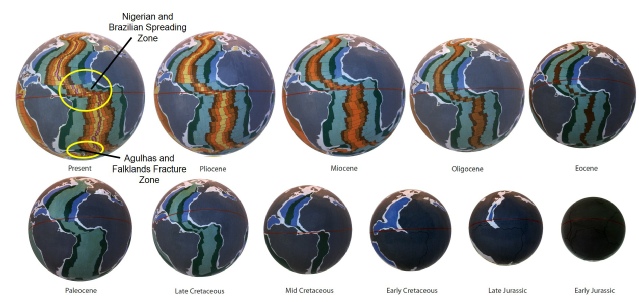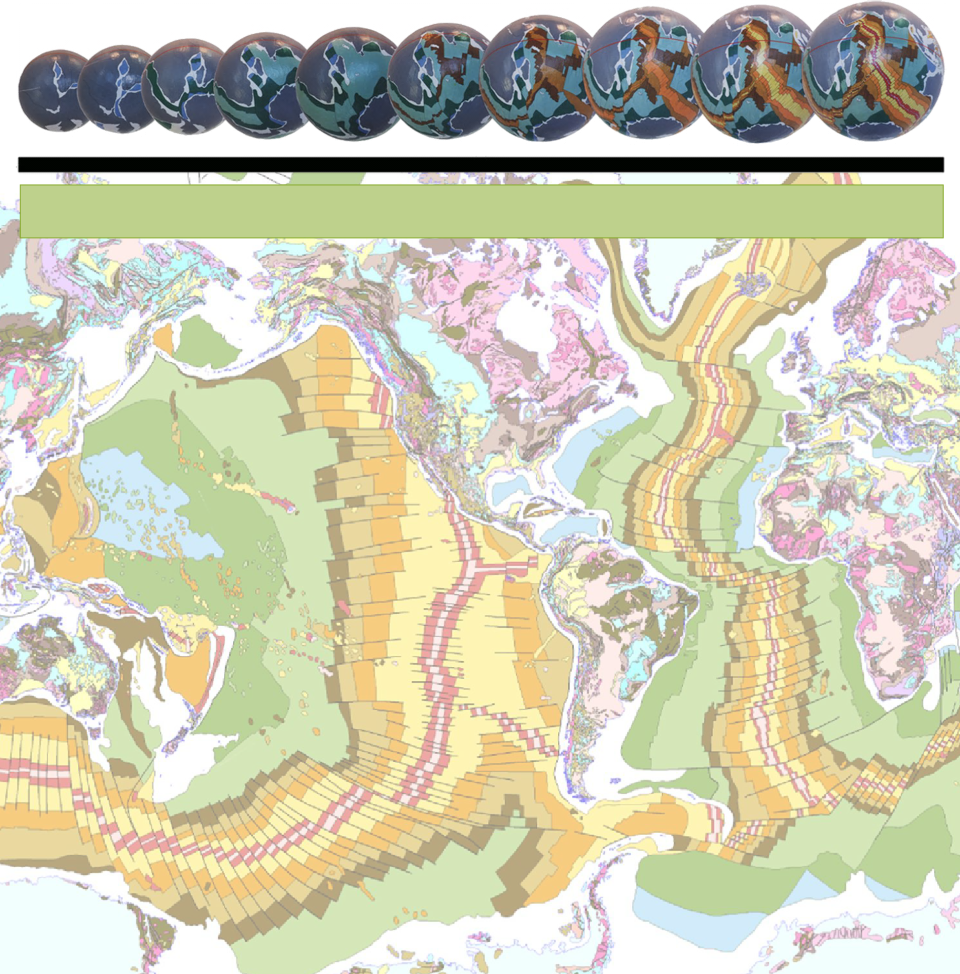ATLANTIC OCEAN
The ability to match the east coast of South America with the west coast of Africa has long been recognised by map makers for many centuries. This remarkable fit-together now forms the conceptual basis for both early continental drift and plate tectonic studies. The closing of the Atlantic Ocean and reconstruction of these continents also forms the basis for assemblage of the Pangaea supercontinent. This fitting together of the South American and African continents is further substantiated by an extensive array of geological evidence dating back to the investigations of Wegener.
On conventional reconstructions of the Atlantic Ocean, the corresponding margins of northern Brazil in South America and Guinea in Africa are traditionally fitted together according to their geological matches. But, unbeknown to most people, fitting these coastlines together produces a narrow triangular gap which widens south between the continental margins of South America and Africa south of the Niger Delta region. To minimise this misfit, the margin of South America may also be fitted against southern Africa south of the Niger Delta region. This then produces a narrow triangular gap between the Guinea and north Brazil coastlines, widening northwards. Unfortunately, this also produces a significantly greater area of misfit in the Florida and Central American regions.
It is significant to note that in 1958, when Professor Carey first reassembled these continents on a spherical model representing the Earth’s modern dimension, Carey noted these very same misfits. He commented that “...if all the continents were reassembled into a Pangaean configuration on a model representing the Earths modern dimensions, the fit was reasonably precise at the centre of the reassembly and along the common margins of north-west Africa and the United States east coast embayment, but became progressively imperfect away from these areas.” Carey concluded from this research that the fit of these ancient continents “...could be made much more precise in these areas if the diameter of the Earth was smaller at the time of Pangaea.”
On Expansion Tectonic small Earth models, just as Carey concluded, when the North and South Atlantic Oceans are closed misfitting between the continental margins of North and South America, Europe, and Africa is entirely eliminated. Opening of these oceans during the Mesozoic and Cenozoic Eras is then shown to be progressive and symmetrical. Subsequent opening of the Atlantic Ocean is also shown to have occurred in conjunction with opening of both the Arctic and Indian Oceans.

Atlantic Ocean Expansion Tectonic small Earth sequential spreading history, extending from the present-day back to the early-Jurassic.
Opening of the North and South Atlantic Oceans on an Expansion Tectonic Earth is shown above to have commenced in the lower right small Earth models during the early- to late-Jurassic Period within the North Atlantic region, located between North Africa and North America. This opening North Atlantic region later extended south to merge with the opening South Atlantic Ocean, as well as west into the Gulf of Mexico and Caribbean regions.
North Atlantic Ocean
Opening of the North Atlantic Ocean on an Expansion Tectonic Earth commenced as a narrow rift basin, located between the east coast of North America and west coast of Africa. Over time, this basin continued to open and progressively extend north into the Arctic Ocean and south into the South Atlantic Ocean. From the early-Jurassic a small counter clockwise rotation of the combined South American and African supercontinent, relative to North America, accelerated opening of the North Atlantic region and also extended the ocean west into what is now the Caribbean Sea. This rotation occurred in sympathy with opening of the Pacific Ocean as each of the adjoining continents continued to adjust for changing Earth radius and surface curvature.
During the early-Cretaceous—about 130 million years ago—the newly formed North Atlantic spreading ridge continued to extend north into the Grand Banks continental shelf, then located between Canada and Iberia. This occurred in response to both continental plate motion and opening of the Caribbean Sea. Rifting between South America and Africa also commenced which then initiated a progressive extension of the spreading ridge into the previously separated North and South Atlantic Oceans.
By the Late Cretaceous—around 80 million years ago—the North Atlantic mid-ocean spreading ridge had continued to extend further north into the Arctic Ocean. This spreading ridge then branched northwest into the Labrador Sea rift zone, located between Canada and Greenland, and northeast into the Mediterranean Sea. The extension and branching of this spreading ridge gave rise to continental break-up and rifting between Canada and Greenland, as well as rifting and rotation of Spain relative to both France and England.
From the late-Cretaceous to the present-day, the North Atlantic mid-ocean-ridge has continued to open in conjunction with both the Nansen-Gakkel spreading ridge within the Arctic Ocean and the South Atlantic spreading ridge. Spreading within each of these areas has resulted in a progressive enlargement of both the North and South Atlantic Oceans and was accompanied by symmetrical seafloor spreading.
South Atlantic Ocean
The South Atlantic Ocean commenced opening between the southern South American peninsular and the South African region as a long narrow rift zone and has continued to steadily open to the present-day. The pattern of coloured seafloor stripes shows that this opening occurred in sympathy with opening of the Indian Ocean. Because of this, these two oceans can be considered as extensions of the same continental crustal rupture and opening event.
Separation between the west coast of Africa and east coast of South America commenced during the late-Jurassic—around 155 million years ago. This opening occurred along the now separated Agulhas and Falklands fracture zones, presently located in the southern South Atlantic Ocean. During late-Jurassic times, continental rifting and separation of the two continents progressively extended north. The South Atlantic spreading ridge then eventually merged with the North Atlantic spreading ridge during the early-Cretaceous along the Nigerian and Brazilian rift zone. From that time on the North and South Atlantic Oceans have remained united as a single Atlantic Ocean.
From the late-Cretaceous—around 80 million years ago to the present-day—spreading in both the North and South Atlantic Oceans has continued along a common mid-Atlantic spreading ridge. Subsequent spreading in both regions continued to be symmetrical, with a slow clockwise rotation of South America, relative to Africa, giving a slightly greater spreading rate in the southern South Atlantic Ocean.


